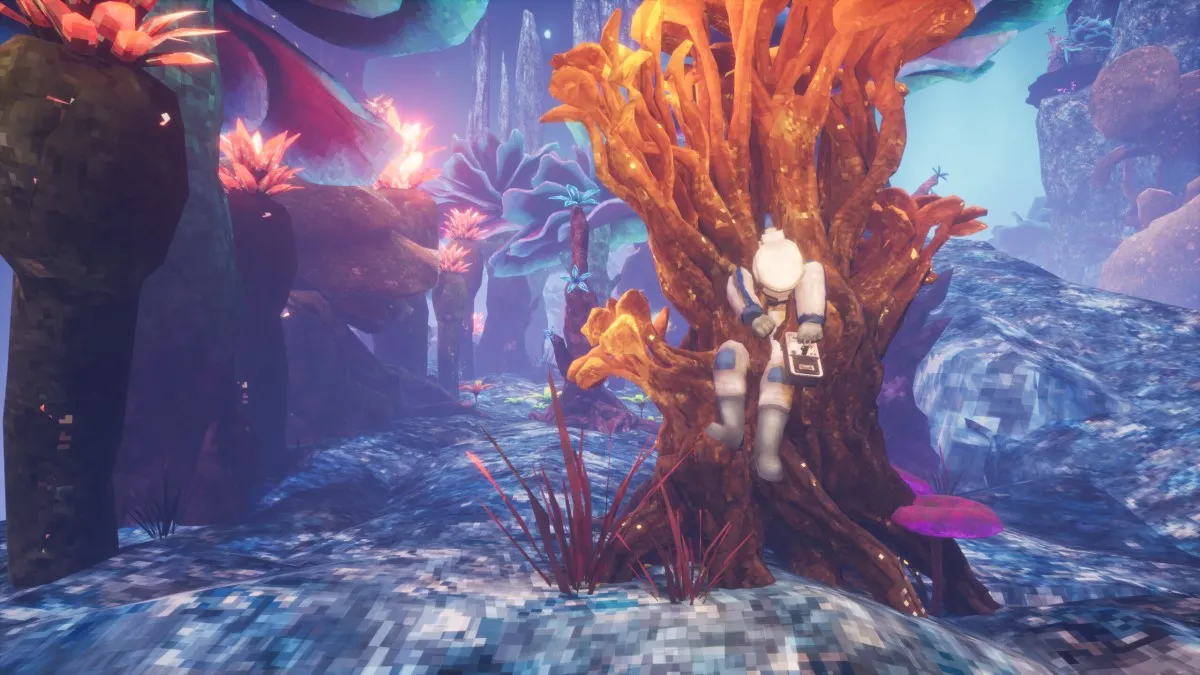A bard’s tale
I want to tell you about a very specific moment in Wandersong. It comes nearly halfway through the game. The bard, our protagonist for this adventure, is absolutely down in the dumps. He’s lethargic, mopey, and has downright given up on himself so much so that he’s back living with his mother in a town full of miserable people. He’s at his lowest of lows, but his mother won’t hear of it. She doesn’t want a sad son, she wants a blissful boy. So, in an effort to appease his doting mother, the bard will force a painfully sad smile on his face anytime he’s looking at his mom.
It’s heartbreaking and comforting all at the same time and the type of small, unnecessary-but-welcomed detail that makes Wandersong one of the most charming games of the year.

Wandersong (Switch [reviewed], PC)
Developer: Greg Lobanov
Publisher: Humble Bundle
Released: September 27, 2018
MSRP: $19.99
The opening of Wandersong finds our protagonist the bard, who I later name Lamb, a bit disappointed with his situation. The world is coming to an end. The goddess Eya, who created the world eons ago with a song, is set to sing a new tune and bring the current universe to an end, replacing it with something new. Only one person is capable of being the hero of this adventure and it is not the bard. Nope, sorry, but saving the world is a task for somebody who actually has the upper body strength to properly wield a sword. The bard can’t do that, he’s too much of a weakling. All he can do is sing, but that might actually be enough to save everyone he cares about.
The bard’s voice is the central mechanic of Wandersong. With the right Joy-Con, I can use the control stick to select a pitch from his voice wheel to solve puzzles or guide my character through various story sections. Sometimes this means helping a young musician connect with her dead mom, other times it means leading a group of pirates in a sea chanty as we sail from island to island. Wandersong can best be described as a side-scrolling adventure game with light puzzle, rhythm, and platforming sections. This isn’t a game that’s going to challenge anyone, rather, it’s an eclectic journey for players to enjoy from beginning to end. And what makes this game so damn enjoyable is the story.
In the Kickstarter page for Wandersong back from 2016, developer Greg Lobanov named dropped Earthbound, Over the Garden Wall, and My Neighbor Totoro as influences on the story. All top quality references, but the title I can’t stop thinking about while playing is Paper Mario: Color Splash. Or really, any title in the Paper Mario series except for that 3DS one. When I see the rhythm of the comedy, how the story goes from levity into its more poignant moments before pulling me back up with humor, I can’t shake the feeling that Lobanov is borrowing the series’s flow and formula with wonderful results.
Every act of the story is a brand new setting with new characters, new jokes, and new revelations about the hero and his companions. There is also at least one out-of-left-field Sheryl Crow reference. The bard is hilarious, approaching his quest with an endearing naivety that best suits a narrative as it ventures on paths both jolly and emotional. Along for much of the ride is Miriam, an incorrigible witch who finds their journey futile, but starts to show her true self the further away from home she travels. There are other cast members too, but to write of their personal developments would stray a bit too far into spoiler territory.
The acts also introduce new twists on the bard’s singing mechanic players will use when they travel to meet each Overseer. The flow of each act follows a similar formula, though the contents of each act greatly differ. The bard will arrive in a new location, meet the villagers, solve their central problem with his singing, and then learn a song that will grant him access to the spirit world. This is where I put those new mechanics, such as controlling wind or the speed of platforms, into use while navigating the game’s light platforming sections. Nothing is too difficult and if I “die,” the game is quite generous with checkpoints.
It’s also generous with how talented I am in regards to the controls. For a vast majority of the game, everything works exactly as it should. Nothing really gives me trouble until I reach the moments where Wandersong actually requires some rhythm. Most puzzles don’t require me to keep a beat as they’re more akin to a game of Simon. But when I have to perform the song to enter the spirit world, I have to actually hit the notes on the voice wheel in time. I’m not sure the small analog sticks on the Joy-Con are ideal for the precision required here. I never fail these portions, but I can tell I hit notes far too late.

What bothers me most about screwing up these portions is not that I miss a note or two but that I feel I’m taking away from the excellent audio found throughout Wandersong. The bard is able to sing at nearly any time in the game which is a fantastic showcase of the sound design. His tone will change depending on his mood. When he’s sad and depressed, he barely emits any noise. When he’s at his happiest, he’s belting tunes like a nun on a Swiss Alp. The singing mechanic is so clever I tend to overuse it, sometimes robbing me of the equally impressive score by A Shell in the Pit.
The soundtrack to Wandersong does everything it can to lighten the mood, and the wonderful storybook art direction certainly helps it look the part of a lighthearted romp, but buried beneath the sunny exterior is something morose. The core of the narrative revolves around duty and destiny, and the feeling of helplessness you can feel when trying to tackle a problem far beyond your capabilities. The more I focus on this convalescence the worse I feel about the experience, though if I ever become too disheartened, I can just press the dance button and watch the bard shake his hips and wiggle his wrist like a someone ought to put a ring on it.
Wandersong is the most emotionally satisfying game I’ve played in 2018. It’s a rollercoaster ride through the spectrum of feelings, all wrapped up in a lovingly crafted construction paper world. I didn’t even know this game existed a month ago. Now, it’s one I’ll never forget.
[This review is based on a retail build of the game provided by the publisher. Destructoid writer Jonathan Holmes has a candy shop named after him in the game. As always, no relationships will be factored into coverage.]






Published: Sep 30, 2018 10:59 am